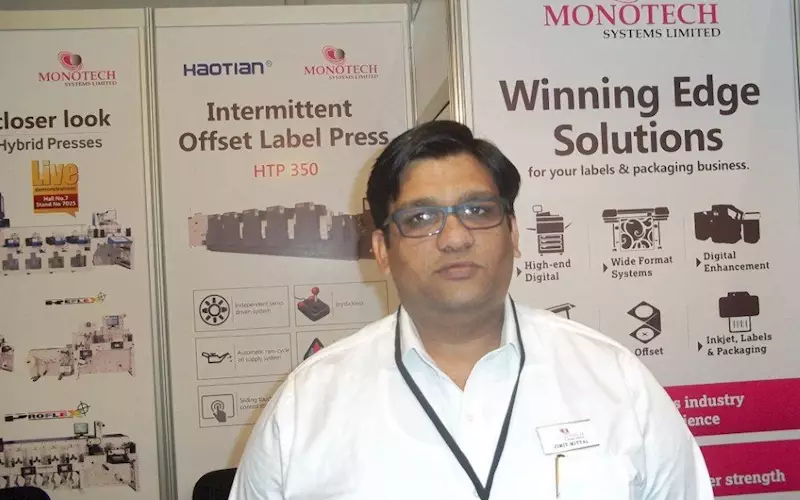Yes, says Jimit Mittal, general manager for inkjet system at Monotech. He discusses with Noel D’Cunha, how Monotech’s customers are responding to a new reality looking beyond the once sure offset and flexo process.
PrintWeek India (PWI): Monotech sold of its digital print business to Konica Minolta. That was one of the big news. What is happening with the Jetsci business? How’s the growth there?
Jimit Mittal (JM): We started the labels and packaging divison with our own manufactured inkjet printing solutions-Jetsci towards the end of 2012. The last Labelexpo was the starting point for us in this segment.
Since, then we have installed close to 35 systems to more than 20 customers, which is a good number for us.
In the last two years, we have announced the association with many world leading companies catering to labels and packaging. For example, in the flexo printing, it is UK’s Focus Labels and another in the security software vertical. We see a very good growth into this industry.
PWI: How does the label printing sector looked like in 2015? What are you hearing from your customers, who have been using your products in the last two years?
JM: Right now most of the products we installed into labels and packaging are inkjet systems for variable data printing and it is good to hear the response from the customers as we have many customers with multiple installations which itself speaks about the solution. We have provided the solutions for simple to very difficult applications.
PWI: In terms of functionality, has the role of labels enhanced or it still is a piece of decoration?
JM: Labels are and will continue to be the integral part of any brand owner. Label speaks about the product and its value. So there is tremendous growth and demand for the enhancement of the label production.
PWI: New guidelines for product security and ingredients disclosures are being introduced on a regular basis. Do you see labels donning a bigger role here?
JM: Yes, the product security is a major challenge now-a-days, as more than 15% of the revenues are eaten up by the counterfeiters as well as raising concerns on health. With right tools we can at least minimise these bad affects through secured labels and awareness to consumers.
PWI: There are new substrates, linerless to name one, plus processes. How should the labelers address these challenges?
JM: Many manufactures are working on it and hopefully the great/economical solution coming is not so far.
PWI: Short-run work and just-in-time delivery are fast, becoming the norm. And to remain a competitive supplier and meet these changing demands, what should the Indian label printers do to improve their production methods? How is digital print transforming the label industry?
JM: First of all, digital technology is not the replacement market to conventional printing methods, it is to complement conventional technology where the label manufacturers are facing the lead time issues as well as the initial setup costs and if we add the value to product with variable data for unique identification of every label.
To be competitive as label manufacturers one has to be forward and keep on investing into the newer technologies and innovations.
PWI: Rising SKU, short print runs are putting pressure on flexo presses, which were designed to handle fewer jobs because of their time consuming and expensive make ready processes. What improvements are we seeing in the capabilities of flexo presses that can turn marginal short-run jobs into sustainable, profitable ones?
JM: Having a flexo press with digital solution on the production, floor can be a very good combination, is a multi-purpose solution, and gives more flexibility in terms of time and cost.
PWI: One of the ways of becoming profitable is by reducing cost. Do you believe it is? Both digital and flexo presses claim to be the savours? How do you see it?
JM: Profitability cannot come only by reducing cost actually in my opinion innovative products and value addition will help increase profitability. There are thousands of label printers in India who can produce similar jobs but by reducing the costs, there will be increase in competition. Printers need to create a niche, and add a premium tag to their business.
PWI: New technologies in pre-press and finishing, substrate and inks, are enhancing the functionality of labels. In future, what improvements can we expect from the flexo and digital presses?
JM: We can expect a good chemistry of substrates and inks on both the technologies where “one for all” press can come, one press can serve all purpose whether you need to run various substrates or its inks with great colour combinations.
PWI: What's the "next big thing" that you see is coming in the label segment?
JM: Successful combination of flexo and digital full colour platform. I also see advancement in brand protection tools.












 See All
See All